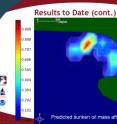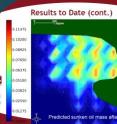UM researchers develop model for locating and forecasting sunken oil following spills
Related images
(click to enlarge)
A team of researchers at the University of Miami (UM) has developed a computer model for finding and projecting in time sunken oil masses on the bottom of bays, after an oil spill. The unique model can be used in oil spill planning, response, and recovery applications. "Sunken oil is difficult to 'see' because sensing techniques show only a small space at a point in time. Moreover, the oil may re-suspend and sink, with changes in salinity, sediment load, and temperature, making fate and transport models difficult to deploy and adjust," says James Englehardt, UM professor of environmental engineering in the College of Engineering and team leader for the project. "For these reasons, we have developed a unique approach to the problem, bridging sampling plan techniques with pollutant transport modeling, to create models of sunken oil.
The model was developed for the Emergency Response Division of NOAA/NOS/OR&R (NOAA's Ocean Service Office of Response and Restoration), in Seattle, and the project was funded by the Coastal Response Research Center, University of New Hampshire.
The two-year project had three main objectives:
- compile and summarize data on the occurrence of sunken oil, directed by the project team including end users and NOAA liaison;
- develop a 2-D multimodal predictive Bayesian Gaussian model of sunken oil locations across a bay to accept spatial field data and hydrodynamic information and forecast sunken oil locations in time; and
- verify the model versus sunken oil data, as possible, and simulated datasets.
Source: University of Miami
Other sources
- Computer model for locating and forecasting sunken oil following spillsfrom Science DailyThu, 27 May 2010, 7:31:40 UTC
- UM researchers develop model for locating and forecasting sunken oil following spillsfrom Science BlogWed, 26 May 2010, 20:41:42 UTC
- UM researchers develop model for locating and forecasting sunken oil following spillsfrom PhysorgWed, 26 May 2010, 20:41:37 UTC


